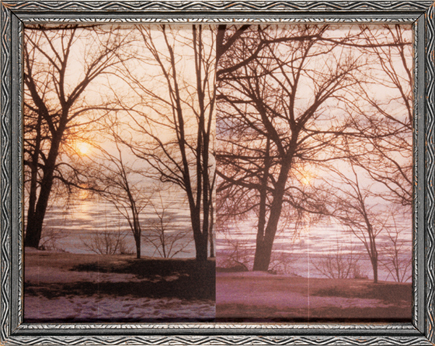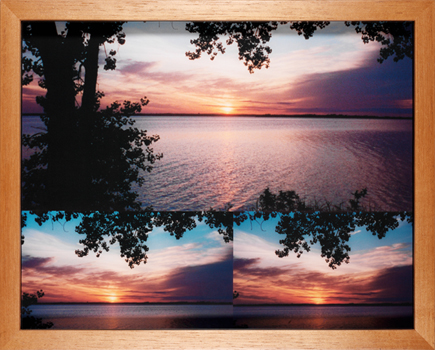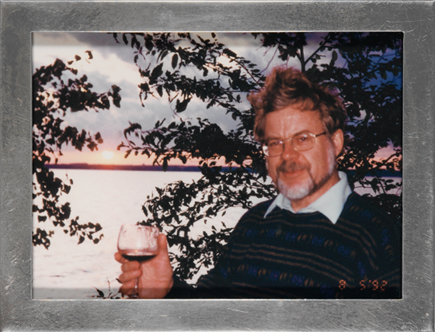








The Dad Tapes / The Mom Photographs: Sunsets – 2007
27 inkjet prints, variable sizes, and a five minute video
The Dad Tapes / The Mom Photographs is a photography and video installation. The main projection, Chronology, compiles an hour of short clips that track a 30 year history of simultaneous recordings: my father’s videotaping and my mother’s photographing of our family. Sunsets, the second part of the installation, marks another instance of my mother and father’s shared interest: the setting sun viewed from their cottage. My parents’ need to document, rather than simply experience their family and surroundings, while driven by a want to express love, actually stifled that expression with all the trappings of preparation that go into recording. Yet still, these images allow us to remember.
The act of trying to capture everything on videotape is imbued with a sense of impending loss. When compiled, a family’s archive of home videos feels like an attempt to stop time by taping every moment for posterity. Yet, upon reviewing a survey of such an archive, the effect is quite opposite: life passes by so quickly and the recording of that life ends up only emphasizing its impermanence. A family snapshot contains the wonder that comes from being able to scrutinize each subject in a frozen moment. Often the images are carefully constructed and the subject is almost always asked to smile but, “no matter how artful the photographer, no matter how carefully posed his subject, the beholder feels an irresistible urge to search such a picture for the tiny spark of contingency, of the Here and Now, with which reality has so to speak seared the subject, to find the inconspicuous spot where in the immediacy of that long-forgotten moment the future subsists so eloquently that we, looking back, may rediscover it.” [i]
Chronology makes the act of getting ready for a photograph the subject of this home-video survey. By weaving the photographs and the video together an interesting balance is achieved, the same moment is recorded from two different perspectives with two different mediums. The consciousness of one’s mortality realized by the collection of videos is contrasted by the timeless immediacy of the photographs.
Sunsets, the other component of the installation, documents how my mother and father repeatedly recorded something that they both find beautiful, the setting of the sun on the water. It is comprised of images and video taken at different times from the same vantage point at their cottage on Lake Champlain. The photographs are framed and mounted on the wall and below them the video is looped on a monitor. The repetition within this work suggests the habitual desire to capture a moment even though photographic reproduction never quite manages to get that beauty of the sun just right.
The Dad Tapes / The Mom Photographs is an attempt to understand the meaning of my parents’ constant desire to record. It is a meditation on the experience of being their subject. My parents’ syncronized filming reminds me of one of Rilke’s letters, where the author counsels a young poet to “be considerate of aging people, who fear that being-alone in which you trust. Avoid contributing material to the drama that is always stretched taut between parents and children; it uses up much of the children’s energy and consumes the love of their elders, which is effective and warming even if it does not comprehend. Ask no advice from them and count upon no understanding; but believe in a love that is being stored up for you like an inheritance and trust that in this love there is a strength and a blessing, out beyond which you do not have to step in order to go very far!” [ii]
What I once perceived as my parents’ excessive want to film and photograph, I have come to understand through this video projection, as an expression of their love.
[i] Walter Benjamin, ‘Kleine Geschichte der Photographie’, Die Literarische Welt, Nos. 38;39;40 (Berlin, 18 September; 25 September; 2 October 1931); trans. Phil Patton ‘A Short History of Photgraphy’, Artforum, vol.15, no. 6 (New York, February 1977); reprinted in Charles Merewether, ed., The Archive: Documents of Contemporary Art (London/Cambridge: Whitchapel/MIT Press, 2006) 58.
[ii] Rainer Maria Rilke, Letters to a Young Poet, trans. M. D. Herter Norton (1934); reprinted (New York: W. W. Norton & Company Inc., 1993) 39 – 40.
Acknowledgments : Canada Council for the Arts, Jim and Ann Waldron, Jay Waldron, Jack Stanley, Jean-Michel Ross.